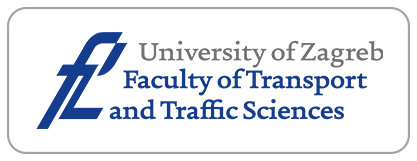Eco-Efficiency Evaluation of Integrated Transportation Hub Using Super-Efficiency EBM Model and Tobit Regressive Analysis – Case Study in China

Downloads
The transportation industry is a key area for ecological civilisation construction and low-carbon development. As the core support of the national integrated transportation system, the ecological development level of integrated transportation hub (ITH) is crucial for enhancing
the sustainable development capacity of the national integrated transportation. An eco-efficiency evaluation index system of ITH is established in this study and the eco-efficiencies of twenty international ITHs in China are comprehensively evaluated based on the super-efficient epsilon-based measure (EBM) model. Then the panel Tobit regression model is adopted to analyse the influencing factors of eco-efficiency. The results show that the average eco-efficiency of ITHs in China during 2011–2021 declines first and then rises, with a relatively high level overall but not efficient yet, and there is an obvious gradient distribution characteristic in all eco-efficiencies. Among them, Guangzhou ranks first, followed by Haikou, and Harbin ranks last. It is found that integrated transportation efficiency, urban green coverage, level of opening-up and economic development improve eco-efficiency significantly, while urbanisation rate, industrial structure and technology input have a negative impact. The results are consistent with the actual situation, verifying the practicality of models, and can be used to promote the sustainable development of integrated transportation.
Downloads
Álvaro C, et al. Evaluating public transport efficiency with neural network models. Transportation Research Part C: Emerging Technologies. 1997;5(5):301-312. DOI: 10.1016/S0968-090X(97)00017-X.
Kuang, M. Transport efficiency theory: Theory and practice of optimizing the allocation of transport resources. Beijing, China: China Railway Publishing House; 2005.
Tomazinis AR. A study of efficiency indicators of urban public transportation systems. Washington, DC, US: United States Department of Transportation (USDOT); 1977.
Erdei L, et al. Improving the efficiency of rail passenger transportation using an innovative operational concept. Sustainability. 2023;15(6):5582. DOI: 10.3390/su15065582.
Henke I, et al. Airport efficiency analysis in Europe including user satisfaction: A non-parametric analysis with DEA approach. Sustainability. 2022;14(1):283. DOI: 10.3390/su14010283.
Gutiérrez E, et al. Evaluating efficiency of international container shipping lines: A bootstrap DEA approach. Marit. Econ. Logist. 2014;16:55-71. DOI: 10.1057/mel.2013.21.
Georgii P, et al. Development of methods to increase the efficiency of road transportation by international transport corridors. Technology Audit and Production Reserves. 2020;4:34-36. DOI: 10.15587/2706-5448.2020.210379.
Lewis S, Cook P, Minc M. Comprehensive transportation models: Past, present and future. Transportation. 1990;44(2):249-265. DOI: 10.1080/01441649008716752.
Kawata H, Iida Y. Case study of evaluation for comprehensive transportation policy. Proceedings of Infrastructure Planning. 1999;22(1):511-514.
Hood N, et al. Vulnerability assessment through integrated transportation analysis. Journal of the Transportation Research Board. 2003;1822(1):18-23. DOI: 10.3141/1822-0.
James MS. Challenges and opportunities for transportation: Implementation of the clean air act amendments of 1990 and the intermodal surface transportation efficiency act of 1991. Transportation. 1995;22:193-215. DOI: 10.1007/BF01099470.
Karlaftis MG, et al. Efficiency measurement in public transport: Are findings specification sensitive? Transportation Research Part A. 2012;46(2):392-402. DOI: 10.1016/j.tra.2011.10.005.
Jia P, Hu Y, Yuan S. Research on the efficiency and spatial relevance of provincial comprehensive transportation in China. Science Research Management. 2020;41:219-229. DOI: 10.19571/j.cnki.1000-2995.2020.09.022
Zhang JB, Chen, QL. Analysis of spatial-temporal evolution and influencing factor in regional integrated transport efficiency differences. Journal of Guizhou University (Social Sciences). 2019;37(06):34-42. DOI: 10.15958/j.cnki.gdxbshb.2019.06.07.
Rygzynov TS, et al. Efficiency of transport infrastructure in Asian Russia, China, Mongolia, and Kazakhstan in the context of creating new trans-Eurasian transport corridors. Sustainability. 2023;15(12):9714. DOI: 10.3390/su15129714.
Sami J, Pascal F, Younes B. Public road transport efficiency: A stochastic frontier analysis. Journal of Transportation Systems Engineering & Information Technology. 2013;13(5):64-71. DOI: 10.1016/S1570-6672(13)60123-3.
Graham DJ. Productivity and efficiency in urban railways: Parametric and non-parametric estimates. Transportation Research Part E. 2008;44(1):84-99. DOI: 10.1016/j.tre.2006.04.001.
Roháčová V. A DEA based approach for optimization of urban public transport system. Cent Eur J Oper Res. 2015;23:215-233.
Romero-Ania R, de Vicente Oliva MA, Rivero Gutiérrez L. Economic evaluation of the urban road public transport system efficiency based on data envelopment analysis. Applied Sciences. 2022;12:57. DOI: 10.3390/app12010057.
Jing CY, Song HJ, Sun H. Airport capacity expansion and efficiency change in China based on two stage analysis of DEA-Tobit/Logit method. Journal of Transportation Systems Engineering and Information Technology. 2017;17:235-241,249.
Kim J, Kim H. Evaluation of the efficiency of maritime transport using a network slacks-based measure (SBM) approach: A case study on the Korean coastal ferry market. Sustainability. 2021;13:6094. DOI: 10.3390/su13116094.
Ma F, et al. Integrated transport efficiency and its spatial convergence in China’s provinces: A super-SBM DEA model considering undesirable outputs. Applied Sciences. 2018;8:1698.
Dimitrios P, et al. Measuring eco-efficiency of the global shipping sector based on an energy and environmental approach: A dynamic slack-based measure non-oriented model. Energies. 2023;16(19).
Gu Y, Liu W, Loh HS. Port efficiency based on the super-efficiency EBM-DEA-SDM model: Empirical evidence from China. Future Transportation. 2023;3(1):23-37.
Zhou HB, Hu HH. Sustainability evaluation of railways in China using a two-stage network DEA model with undesirable outputs and shared resources. Sustainability. 2017;9:150.
Song X, Hao Y, Zhu X. Analysis of the environmental efficiency of the Chinese transportation sector using an undesirable output slacks-based measure data envelopment analysis model. Sustainability. 2015;7:9187-9206.
Leal IC, et al. A data envelopment analysis approach to choose transport modes based on eco-efficiency. Environment, Development and Sustainability. 2012;14:767-781. DOI: 10.1007/s10668-012-9352-x.
Gokhan E, et al. Transportation related carbon, energy and water footprint analysis of U.S. manufacturing: An eco-efficiency assessment. Transportation Research Part D: Transport and Environment. 2014;32:143-159. DOI: 10.1016/j.trd.2014.07.001.
Lyovin BA, et al. To the question of development of criteria for estimation of energy efficiency and selecting the optimum composition of subsystems integrated transport system of Russia. Transportation Systems and Technology. 2017;3(2):110-111. DOI: 10.17816/transsyst201732110-111.
Ma QF, et al. Green efficiency changes of comprehensive transportation in China: Technological change or technical efficiency change? Journal of Cleaner Production. 2021;304:127115. DOI: 10.1016/j.jclepro.2021.127115.
Ma QF, et al. Dynamic evolution trend of comprehensive transportation green efficiency in China: From a spatio-temporal interaction perspective. Journal of Geographical Sciences. 2022;32:477-498. DOI: 10.1007/s11442-022-1957-x.
Hussain Z, et al. Estimating sustainable transport efficiency and socioeconomic factors: Application of non-parametric approach. Transportation Letters. 2023;15(7):685-697.
Hussain Z. Environmental and economic-oriented transport efficiency: The role of climate change mitigation technology. Environmental Science and Pollution Research. 2022;29(19):1-18.
Akbar U, et al. Energy efficiency in transportation along with the belt and road countries. Energies. 2020;13(2607). DOI: 10.3390/en13102607.
Janic M. Integrated transport systems in the European Union: An overview of some recent development. Transport Reviews. 2001;21(4):469-497.
May AD, Roberts M. The design of integrated transport strategies. Transport Policy. 1995;2(2):97-105. DOI: 10.1016/0967-070X (95)91989-W.
Hull A. Integrated transport planning in the UK: From concept to reality. Journal of Transport Geography. 2005;13(4):318-328. DOI: 10.1016/j.jtrangeo.2004.12.002.
Feng X, et al. Status and research topics in developing ecological transportation system within connected vehicle age with knowledge discovery in database techniques. Environment Pollution and Climate Change. 2017;1(2):1-3. DOI: 10.4172/2573-458X.1000124.
Chen WW, Ou GL. Theoretical understanding of ecological transportation and evaluation of regional ecological transportation status: Taking Beijing as an example. Ecological Economy. 2019;35:94-99. DOI: CNKI: SUN: STJJ.0.2019-05-018.
Inglesi-Lotz R, Dogan E, Nel J, Panayiotis T. Connectedness and spillovers in the innovation network of green transportation. Energy Policy.2023;180.
Hmamed H, Benghabrit A, Cherrafi A, Hamani N. Achieving a sustainable transportation system via economic, environmental, and social optimization: A comprehensive AHP-DEA approach from the waste transportation sector. Sustainability. 2023;15(21).
Van de Ree R, Jaeger JAG, van der Grift EA, Clevenger AP. Effects of roads and traffic on wildlife populations and landscape function: Road ecology is moving toward larger scales. Ecology and Society. 2011;16:48-57.
Schaltegger S, Sturm A. Ökologische rationalität: Ansatzpunkte zur ausgestaltung you okologieorienttierten management instrumenten. Die Unternehmung. 1990;4:273-290.
Camarero M, et al. Eco-efficiency and convergence in OECD countries. Environmental &Resource Economics. 2013;55(1):87-106. DOI: 10.1007/s10640-012-9616-9.
Zheng BY, et al. Analysis of urban traffic efficiency and its influencing factors based on ecological environment. East China Economic Management. 2018;32(06):164-170. DOI: 10.19629/j.cnki.34-1014/f.170729001.
Kiani M, Ardakani DA. Finding causal relationship and ranking of industry 4.0 implementation challenges: A fuzzy DEMATEL-ANP approach. Soft Computing. 2023;27(21):15479-15496.
Jia F, et al. Digital electric travel mode facilitate the realization of "carbon neutrality"—Analysis on carbon reduction data of 2018-2021 based on Didi Chu Xing. World Environment. 2021;5:52-55.
Tone K. A slacks-based measure of efficiency in data envelopment analysis. European Journal of Operational Research. 2001;130(3):498-509.
Tone K, Tsutsui M. An epsilon–based measure of efficiency in DEA: A third pole of technical efficiency. European Journal of Operational Research. 2010;207(3):1554-1563. DOI: 10.1016/j.ejor.2010.07.014.
Chen W, et al. Efficiency evaluation of green technology innovation of China’s industrial enterprises based on SBM model and EBM model. Mathematical Problems in Engineering. 2021;9:1-11. DOI: 10.1155/2021/6653474.
Liang D, et al. Installed hydropower capacity and carbon emission reduction efficiency based on the EBM method in China. Frontiers in Energy Research. 2020;882. DOI: 10.3389/fenrg.2020.00082.
Wang M, Liu DG. Estimation and convergence analysis of China’s provincial agricultural environment efficiency—Super-Efficiency EBM model based on undesired output. Mathematics in Practice and Theory. 2020;50(9):20-27.
Varas-Fuente OJ, Arguedas-Sanz R, Rodrigo-Moya B. Analysis of the influence of the moment the internationalization process begins on the internationalization intensity of family and nonfamily businesses: An approach using a Tobit model. Administrative Sciences. 2022;12(4):133-133. DOI: 10.3390/admsci12040133.
Liang YW, et al. Spatial-temporal evolution and impact effect of agricultural ecological efficiency in the Yellow River Basin. Hubei Agricultural Sciences. 2022;61(1):54-60,101. DOI: 10.14088/j.cnki.issn0439-8114.2022.01.010.
Wang SB, Guo JK. The spatiotemporal evolution and spatial correlation analysis of the overall transportation flow development in Chinese cities. Journal of Arid Land Resources and Environment. 2017;31(02):43-49. DOI: 10.13448/j.cnki.jalre. 2017.042.
Zan ZD. 2023 Digital mobility helps zero carbon transportation. Beijing, China: China Academy of Transportation Science; 2023.
Wei M, Zhang SP, Sun B. A modified evaluation method for airport passenger transport efficiency based on packet network analysis and Tobit model. Science Technology and Engineering. 2023;23(9):3916-3924.
Copyright (c) 2024 Ling Wang, Qi Wang

This work is licensed under a Creative Commons Attribution-NonCommercial 4.0 International License.




















